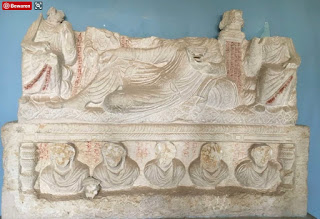ISIS ; Has Destroyed
A Monumental Loss: Here Are the Most Significant Cultural Heritage Sites That ISIS Has Destroyed to Date
Cultural heritage sites continue to be casualties of the ongoing Syrian Civil War.
Palmyra
Occupied by ISIS from: May 2015 to March 2016, and again from December 2016 to March 2017
ISIS has occupied Palmyra twice, and Syrian and Russian forces most recently reclaimed the city in March of this year. During its first occupation in 2015, militants destroyed the Al Lat Lion, a 2,000-year-old statue that once guarded an ancient temple dedicated to the pre-Islamic goddess Al Lat, and was a modern tourist favorite after its excavation in the 1970s, according to BBC.
The lion guarded the Palmyra Museum, and while most of the museum’s artifacts had been moved elsewhere in the country for safekeeping, ISIS defaced what remained. Objects from the museum have also shown up on the black market.
That same summer, ISIS bombed the Temples of Bel and Baalshamin, and nearby of ancient and medieval tombs. The group had intentions to destroy more cultural heritage, leading to the tragic execution of Khaled al-Asaad, the museum’s head of antiquities, who was killed when he refused to reveal the location of precious objects, and charged with “managing Palmyra’s collection of ‘idols.'”
In October, ISIS destroyed the city’s Monumental Arch. Other damage includes the Al Sultaniya Mosque and the Museum of Folk Arts, both destroyed by ISIS-planted bombs. Most recently, during ISIS’s second occupation of the city, the group destroyed the remains of the ancient Roman Tetraplion and part of a nearby Roman theater, sometime between December 2016 and February 2017.
A cemetery near Mosul, Iraq that was defaced by ISIS. Photo courtesy Wikimedia Commons.
Barrel bombs arranged in front of relief panels at Nimrud’s Northwest Palace. Image from video released by ISIS on April 11, 2015.
A picture taken on November 15, 2016, shows destruction caused by the Islamic State (IS) group at the archaeological site of Nimrud. Photo courtesy SAFIN HAMED/AFP/Getty Images)
Nineveh
Occupied by ISIS from: 2014
Once the largest city in the ancient world, Nineveh is a walled city just outside Mosul that contained the massive palace of Assyrian king Sennacherib. Rasheed estimates that 70 percent of what remains has been destroyed.
The Adad Gate and part of the city’s fortification wall were also destroyed, originally dating back more than 2,500 years. Despite being recently replicated in the 20th century, the gates remained symbols of the city’s history.
Raqqa
Occupied by ISIS from: March 2013 until today
A city 160 kilometers east of Aleppo, on the Euphrates river, Raqqa was the first provincial capital to be captured by ISIS, and, functioning as the group’s capital, is one of few cities still occupied.
According to an interactive map published by the New York Times in 2015, ISIS militants destroyed three historic shrines to Islamic figures at the Ammar bin Yasir Mosque, a Shiite pilgrimage site. There has been reported damage to the historic Old City, which was the Abbasid capital between the years 796 and 809, specifically in the area around the Raqqa Museum, which was dedicated to preserving Raqqa’s cultural heritage.
Gabriel explains that US-backed Iraqi forces are currently surrounding the area, and more information about the current state of the city will be available once they gain access.
A funerary relief from the Palmyra Museum, before it was intentionally defaced by members of ISIS. Photos courtesy the Syrian Directorate-General of Antiquities and Museums.
A funerary relief from the Palmyra Museum, after it was intentionally defaced by members of ISIS. Photos courtesy the Syrian Directorate-General of Antiquities and Museums.
-------------------------------------------------------------------------Why...???










Comments
Post a Comment
Thank you for your response
Kind regards Pierre